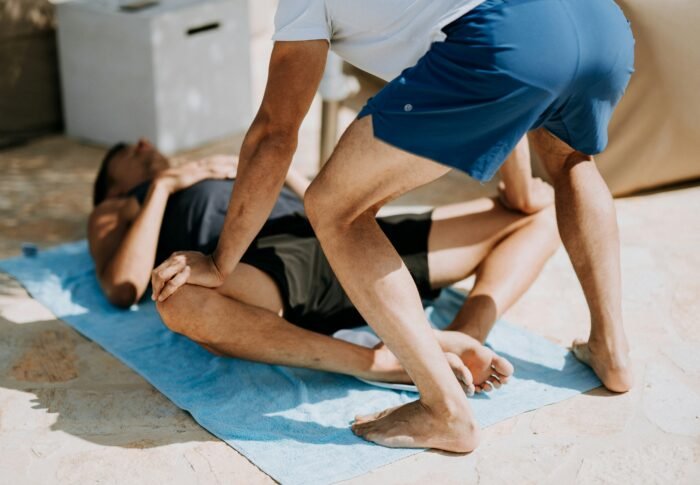
Mastering Basic Dog Training Commands
Are you looking to establish a strong bond with your furry friend and improve their behavior? Look no further! In this article, you will discover the key to mastering basic dog training commands. From sit and stay to come and heel, these commands form the foundation for a well-behaved and obedient pooch. By following some simple and effective techniques, you will be on your way to becoming a dog training master in no time. So, grab your dog’s favorite treats, find a quiet spot, and let’s get started on this exciting journey of training together!
Find products like these on Amazon!
1. Sit Command
1.1. Teaching the Sit Command
Teaching your dog the Sit command is an essential first step in their training journey. Begin by holding a treat close to your dog’s nose, then slowly move the treat upwards and towards the back of their head. As your dog follows the treat with their nose, their bottom will naturally lower into a sitting position. Once they are in a sitting position, praise them and reward them with the treat. Repeat this process several times until your dog starts to understand the association between the word “Sit” and the desired action.
1.2. Reinforcing the Sit Command
Consistency is key when reinforcing the Sit command. Practice the command in various locations and with different distractions to ensure that your dog follows the command in any situation. Always reward them with praise and treats when they successfully respond to the Sit command. Additionally, consider incorporating hand signals along with the verbal command to reinforce the desired behavior. With regular practice and positive reinforcement, your dog will become more consistent in their response to the Sit command.
1.3. Troubleshooting the Sit Command
If your dog is having difficulty understanding or responding to the Sit command, there are a few troubleshooting techniques you can try. Firstly, make sure that you are using a clear and consistent verbal cue, such as saying “Sit” in a firm and upbeat tone. Additionally, check your body language and ensure that you are standing straight and facing your dog when giving the command. If your dog continues to struggle, try using a treat lure to guide them into the sitting position. With patience and perseverance, your dog will eventually grasp the concept of the Sit command.
2. Stay Command
2.1. Training Your Dog to Stay
Teaching your dog the Stay command is crucial for their safety and the safety of others. Begin by giving the Sit command to your dog. Once they are in a sitting position, hold your hand up in a stop signal while saying “Stay” in a confident yet calm voice. Take a step back, but remain within your dog’s line of sight. If your dog stays in place, praise them and reward them with a treat. Gradually increase the distance and duration of the Stay command, always returning to your dog, praising them, and rewarding them.
2.2. Building Duration for the Stay Command
Building duration for the Stay command requires patience and gradual progression. Start by asking your dog to Stay for a few seconds, then gradually increase the duration to several minutes. It is important to reinforce the Stay command with praise and rewards throughout the training process. If your dog begins to move or break the Stay command, calmly and firmly return them to their original position and restart the command. Consistency is key to building the duration for the Stay command successfully.
2.3. Overcoming Challenges with the Stay Command
If your dog struggles with maintaining the Stay command, there are strategies to help overcome these challenges. One common challenge is when your dog wants to follow you instead of staying in place. In this situation, try using a visual marker, such as a mat or a designated spot, to train your dog to stay in a specific location. Another challenge may arise when your dog becomes easily distracted. Gradually introduce distractions during the Stay command training, starting with mild distractions and progressing to more challenging ones as your dog becomes more proficient. With patience and consistent training, your dog will learn to stay focused and maintain the Stay command even in distracting environments.

This image is property of images.pexels.com.
Find products like these on Amazon!
3. Lie Down Command
3.1. Teaching Your Dog to Lie Down
Teaching your dog the Lie Down command is useful for situations where you need them to be calm and relaxed. Start by commanding your dog to sit, then hold a treat close to their nose and lower it down towards the ground. As your dog follows the treat, their front legs will extend forward, and their body will lower into a lying position. Once they are lying down, praise them and give them the treat. Practice this command regularly, gradually decreasing the need for treats as your dog becomes more proficient.
3.2. Adding Distractions to the Lie Down Command
To ensure that your dog can perform the Lie Down command in various environments, it is crucial to introduce distractions during training. Start by adding mild distractions, such as toys or low-level noises, and gradually increase the level of distractions as your dog progresses. Consistently reinforce the Lie Down command and reward your dog for successfully following the command despite distractions. This will help them understand that the command is applicable in all situations.
3.3. Addressing Issues with the Lie Down Command
If your dog is experiencing difficulty with the Lie Down command, there are a few troubleshooting techniques you can employ. First, check if there are any underlying health issues that may be causing discomfort when lying down. If necessary, consult with a veterinarian to rule out any medical concerns. Another common issue is when dogs continuously pop back up into a sitting or standing position after lying down. In this case, practice the command with increased duration and reward your dog only when they maintain the lie-down position for an extended period. Patience and consistency will help address any issues and improve your dog’s understanding of the Lie Down command.
4. Come Command
4.1. Teaching Your Dog to Come
The Come command ensures that your dog returns to you promptly, which is essential for their safety and obedience. Start by using a long leash during training to give your dog guidance and prevent them from running away. Begin by saying your dog’s name followed by the command “Come” in a positive and inviting tone. Gently pull the leash towards you to encourage your dog to move towards you. Once they reach you, praise and reward them with treats or affection. Gradually increase the distance between you and your dog during training sessions to reinforce their understanding of the command.
4.2. Mastering Recall in Different Environments
Mastering the Come command in different environments is crucial, as your dog should be responsive regardless of the location or distractions. Begin by practicing the Come command in a familiar and controlled environment, such as your backyard or a quiet park. Gradually introduce distractions, such as other people or dogs, and practice the command in different settings. Consistency is key when training the Come command, so always reward your dog for coming to you, even if they took longer than expected. With time and practice, your dog’s recall abilities will improve, making them reliable in any situation.
4.3. Dealing with Common Problems in the Come Command
If your dog is displaying resistance or reluctance to come when called, there are strategies to address these common problems. One issue may be if your dog associates coming to you with the end of enjoyable activities, such as playtime in the park. To overcome this, incorporate intermittent rewards during the training process and ensure that coming to you leads to positive experiences, such as praise, treats, or more playtime. Another challenge may arise if your dog becomes easily distracted by their surroundings. Gradually increase the level of distractions during training to help your dog develop focus and understand that the Come command supersedes distractions. Consistent training, positive reinforcement, and patience are key to overcoming difficulties in the Come command.

This image is property of images.pexels.com.
5. Leave It Command
5.1. Teaching Your Dog to Leave It
Teaching your dog the Leave It command is crucial for their safety and prevents them from picking up harmful or inappropriate objects. Begin by placing a treat in your hand and closing it into a fist. Present your closed hand to your dog and say “Leave It” in a firm yet calm tone. If your dog tries to get the treat, simply close your hand tighter and wait for them to stop trying. Once your dog loses interest in the treat, praise them and offer an alternative treat from your other hand. Repeat this process, gradually introducing more tempting items, such as toys or food on the ground.
5.2. Advancing the Leave It Command with Objects
As your dog becomes proficient in leaving treats or items in your hand, you can advance the Leave It command by placing objects on the ground. Begin by using items of low value, such as a tissue or a small toy, and practice the command as you did with treats in your hand. Gradually increase the value and appeal of the objects as your dog becomes more reliable in their response. Always reinforce the Leave It command with praise, treats, and alternative toys to redirect their attention.
5.3. Handling Challenges in the Leave It Command
If your dog struggles with the Leave It command, particularly when dealing with valuable or highly appealing items, there are strategies to overcome these challenges. One effective approach is to teach the “Drop It” command alongside the Leave It command. This way, if your dog does pick up an item they are not supposed to have, you can ask them to drop it before instructing them to leave it. Additionally, consider using high-value treats during training as an extra incentive for your dog to respond to the Leave It command. Persistency, consistency, and positive reinforcement will help your dog understand and follow the command effectively.
6. Drop It Command
6.1. Training Your Dog to Drop Items
The Drop It command is essential for times when your dog has picked up something they shouldn’t have, promoting their safety and preventing the destruction of valuable belongings. Start by offering your dog a toy or another item that they enjoy holding in their mouth. As they grasp the item, present a second toy or treat and use the command “Drop It” while showing them the alternative item. Most dogs will release the first item to take the second one. When they drop the item, immediately praise them and reward them with the alternative toy or treat. Consistently practice this command with various items to reinforce their understanding.
6.2. Building a Reliable Drop It Command
Building reliability with the Drop It command requires consistent training and reinforcement. Gradually increase the value and appeal of the items your dog is holding when practicing the command. It is crucial to always offer a more desirable alternative item when asking them to drop the current one. Reward your dog for promptly responding to the command and reinforce the behavior consistently to establish a reliable Drop It command.
6.3. Troubleshooting the Drop It Command
If your dog is having difficulty letting go of items or becomes possessive over certain objects, there are strategies to troubleshoot and address these challenges. One effective technique is to practice the command in controlled environments, such as during training sessions, before introducing real-life scenarios. Additionally, consider using positive reinforcement techniques, such as trading the item for a high-value treat or rewarding your dog with praise and affection for complying with the Drop It command. In cases of possessiveness, seek professional advice from a certified dog trainer to ensure the safety of both you and your dog.

This image is property of images.pexels.com.
7. Heel Command
7.1. Teaching Your Dog to Heel
The Heel command is useful for walks and outings, as it ensures that your dog walks calmly by your side without pulling on the leash. Start by attaching a leash to your dog’s collar or harness and hold it close to your body. Begin walking, and as soon as your dog starts to pull or move ahead, change direction and say “Heel” in a firm and calm voice. When your dog returns to your side, reward them with praise and a small treat. Repeat this process consistently during walks to reinforce the Heel command.
7.2. Practicing Loose Leash Walking
Practicing loose leash walking is essential for reinforcing the Heel command. Encourage your dog to walk alongside you without pulling on the leash by using gentle leash corrections and praising them when they maintain a loose leash. Consider using treats or a clicker to mark and reward your dog for walking nicely by your side. Gradually increase the duration and distance of loose leash walking to reinforce their understanding of the Heel command.
7.3. Overcoming Common Issues in the Heel Command
If your dog continues to struggle with the Heel command, particularly if they are easily distracted or prone to pulling on the leash, there are techniques to overcome these challenges. One approach is to incorporate positive reinforcement, using treats, praise, or toys, to reward your dog for maintaining a Heel position. Additionally, consider using a front-clip harness or head halter to discourage pulling and redirect your dog’s attention back to you. Consistent practice, patience, and positive reinforcement will help your dog grasp the concept of walking calmly by your side.
8. Off Command
8.1. Teaching Your Dog to Get Off
Teaching your dog the Off command is crucial for times when they jump on people or furniture. Start by using a consistent verbal cue, such as “Off” or “Down,” whenever your dog jumps or gets on something they shouldn’t. Simultaneously, gently guide your dog off the person or furniture. As they respond to the command and get off, praise them and offer an alternative behavior, such as a sit or a down. Consistently reinforce this command whenever your dog jumps or tries to get on something.
8.2. Applying the Off Command to Furniture
Applying the Off command to furniture requires consistent training and redirection. If your dog tends to jump on furniture, catch them in the act and immediately use the Off command while using gentle physical guidance to remove them from the furniture. Redirect their behavior by showing them an alternative, appropriate place to relax, such as a bed or a designated mat. Reward your dog for responding to the Off command and consistently reinforce the desired behavior.
8.3. Handling Challenges with the Off Command
If your dog continues to struggle with the Off command, particularly if they are persistent in jumping or getting on furniture, there are strategies to address these challenges. One approach is to make the inappropriate behavior less rewarding by denying access to the furniture or person they are jumping on. Redirect their attention to an appropriate behavior and reward them for following that behavior instead. Consistent reinforcement, redirection, and positive reinforcement techniques will help your dog understand and respond to the Off command effectively.
9. Wait Command
9.1. Teaching Your Dog to Wait
Teaching your dog the Wait command is valuable for times when you need them to pause or stay in one place temporarily. Start by giving your dog the Sit command and then use a hand signal, such as a flat palm held up, along with the verbal command “Wait.” Take a step back and wait a few seconds before returning to your dog and praising them. Gradually increase the duration and distance of the Wait command, always returning to your dog and reinforcing the behavior.
9.2. Introducing the Wait Command at Doors
Introducing the Wait command at doors is particularly important for your dog’s safety when entering or exiting a property. Begin by having your dog on a leash and approach the door while giving them the Sit command. Open the door slightly and say “Wait.” If your dog remains in position, praise them and reinforce the behavior. If they try to rush through the door, calmly close it and repeat the process until they understand that they must wait for your signal to proceed. Gradually increase the duration of the Wait command at doors to reinforce their obedience.
9.3. Troubleshooting the Wait Command
If your dog struggles with the Wait command, particularly when it comes to staying in place or waiting at doors, there are techniques to troubleshoot and address these challenges. One approach is to practice the command with increased distractions, starting with mild distractions, such as toys or treats placed nearby, and gradually increasing the level of distractions as your dog becomes more proficient. Additionally, consider using a visual marker, such as a mat or a designated spot, to train your dog to wait in a specific location. Consistent training, positive reinforcement, and patience will help your dog understand and comply with the Wait command effectively.
10. Release Command
10.1. Teaching Your Dog the Release Command
The Release command is used to signal the end of a command or a period of restraint, allowing your dog to resume normal behavior. To teach the Release command, use a consistent verbal cue, such as “Okay” or “Free,” while simultaneously presenting an open hand or an inviting gesture. As you give the release command, encourage your dog to move freely, play, or relax. Praise and reward them for responding to the command, reinforcing the concept of release.
10.2 Using the Release Command in Various Situations
Using the Release command in various situations is crucial to ensuring that your dog follows the command consistently. Practice the Release command after successfully completing other commands, such as Sit or Stay, to signal that your dog can now resume their normal behavior. Additionally, use the Release command in situations where your dog may need to be temporarily restrained, such as during grooming or veterinary examinations. By consistently incorporating the release command, your dog will understand when they are free to proceed.
10.3. Dealing with Difficulties in the Release Command
If your dog struggles to understand or respond to the Release command, there are techniques to address any difficulties. First, ensure that you are using a clear and consistent verbal cue along with an inviting gesture or hand signal. If your dog does not respond to the command initially, gently guide them into a relaxed position and reissue the Release command. Consistency is key, so practice the command regularly in various situations to reinforce their understanding. Over time, your dog will become more reliable in their response to the Release command.
Mastering basic dog training commands is an integral part of responsible pet ownership. By teaching your dog commands such as Sit, Stay, Lie Down, Come, Leave It, Drop It, Heel, Off, Wait, and Release, you can establish clear communication and ensure their safety and obedience in various situations. Remember to use positive reinforcement techniques, consistency, and patience throughout the training process. With time and practice, you and your furry friend will build a strong bond and enjoy a mutually beneficial relationship based on trust and understanding.
Find products like these on Amazon!







-
-
1 day
Tagged behavior modification, Techniques, tips